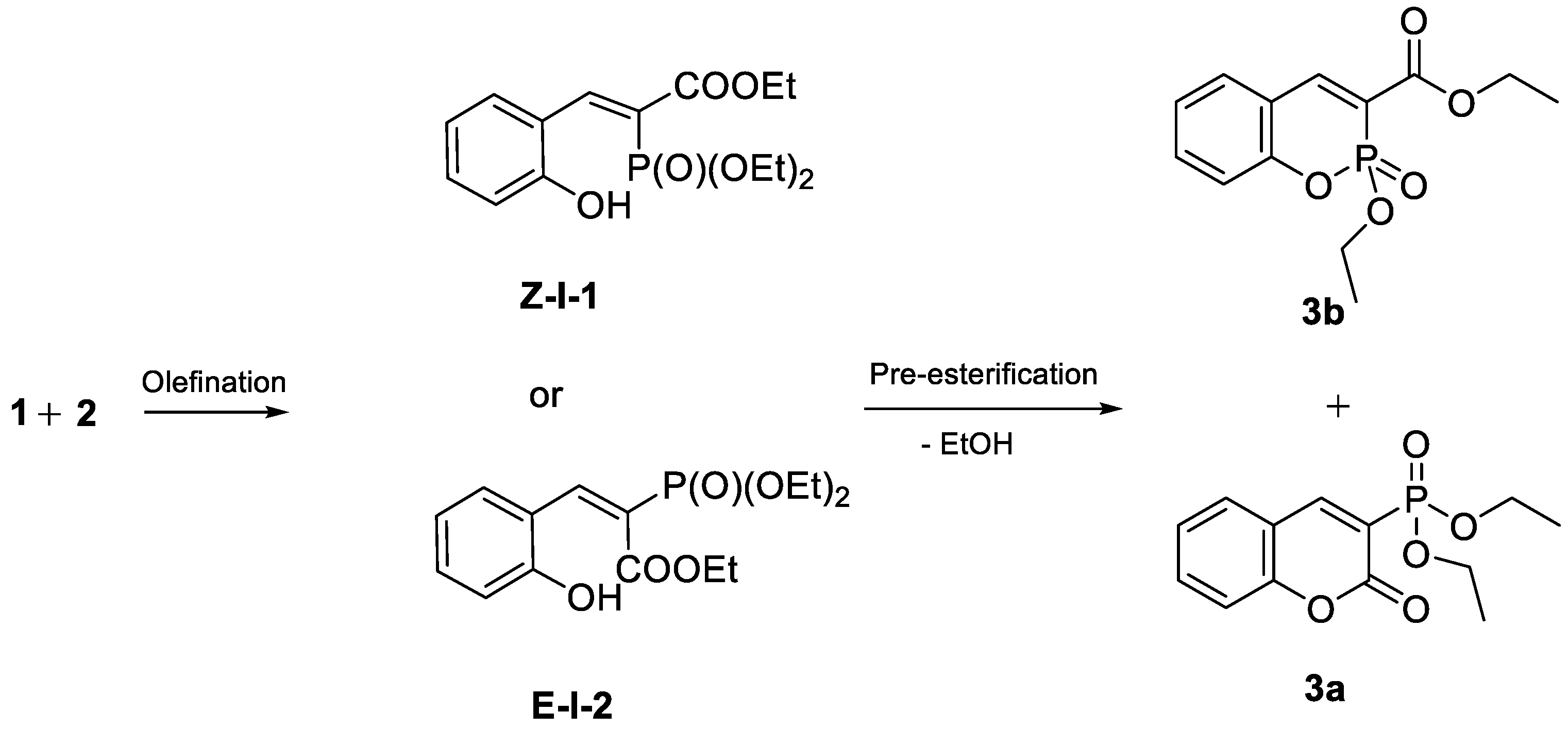3-((λ3-Oxidanylidene)(propylamino)methyl)-2-ethoxybenzo[e]-[1,2]oxaphosphinine-2-oxide
Abstract
:1. Introduction
2. Results
3. Discussion
4. Materials and Methods
4.1. General Procedure for the Preparation of 2-Ethoxy-N-propylbenzo[e][1,2]oxaphosphinine-3-carboxamide-2-oxide 4
4.2. 2-Ethoxy-N-propylbenzo[e][1,2]oxaphosphinine-3-carboxamide-2-oxide, 4
5. Conclusions
Supplementary Materials
Author Contributions
Funding
Data Availability Statement
Acknowledgments
Conflicts of Interest
References
- Kitson, R.; Millemaggi, A.; Taylor, R. The Renaissance of a-Methylene-g-butyrolactones: New Synthetic Approaches. Angew. Chem. Int. Ed. 2009, 48, 9426–9451. [Google Scholar] [CrossRef]
- Zhang, S.; Won, Y.-K.; Ong, C.-N.; Shen, H.-M. Anti-Cancer Potential of Sesquiterpene Lactones: Bioactivity and Molecular Mechanisms. Curr. Med. Chem. Anti-Cancer Agents 2005, 5, 239–249. [Google Scholar] [CrossRef] [PubMed]
- Janecka, A.; Wyrębska, A.; Gach, K.; Fichna, J.; Janecki, T. Natural and synthetic α-methylenelactones and α-methylenelactams with anticancer potential. Drug Discov. Today 2012, 7, 561–572. [Google Scholar] [CrossRef]
- Albrecht, L.; Albrecht, A.; Janecki, T. α-Alkylidene-γ- and δ-lactones and lactams. In Natural Lactones and Lactams: Synthesis, Occurrence and Biological Activity; Janecki, T., Ed.; Wiley-VCH: Hoboken, NJ, USA, 2014; pp. 147–192. ISBN 9783527666911. [Google Scholar] [CrossRef]
- Perucca, E. The new generation of antiepileptic drugs: Advantages and disadvantages. Br. J. Clin. Pharmacol. 1996, 42, 531–543. [Google Scholar] [CrossRef]
- Wong, M.; Defina, J.; Andrews, P. Conformational Analysis of Clinically Active Anticonvulsant Drugs. J. Med. Chem. 1986, 29, 562–572. [Google Scholar] [CrossRef]
- Tasso, S.; Bruno-Blanch, L.; Moon, S.; Estiú, G. Pharmacophore searching and QSAR analysis in the design of anticonvulsant drugs. J. Mol. Struct. (Theochem.) 2000, 504, 229–240. [Google Scholar] [CrossRef]
- Hussain, H.; Hussain, J.; Al-Harrasi, A.; Krohn, K. The chemistry and biology of biscoumarins. Tetrahedron 2012, 68, 2553–2578. [Google Scholar] [CrossRef]
- Sennikova, V.V.; Zalaltdinova, A.V.; Sadykova, Y.M.; Khamatgalimov, A.R.; Gazizov, A.S.; Voloshina, A.D.; Lyubina, A.P.; Amerhanova, S.K.; Voronina, J.K.; Chugunova, E.A.; et al. Diastereoselective Synthesis of Novel Spiro-Phosphacoumarins and Evaluation of Their Anti-Cancer Activity. Int. J. Mol. Sci. 2022, 23, 14348. [Google Scholar] [CrossRef]
- Dziuba, K.F.; Frynas, S.; Kozioł, A.E.; Szwaczko, K. Synthesis and Structural Elucidation of P-stereogenic Coumarins. Symmetry 2024, 16, 73. [Google Scholar] [CrossRef]
- Chen, C.H.; Fox, J.L.; Lippert, E.K. Synthesis of phosphacoumarins and phosphonocoumarins. Two new classes of fluorescent dyes. J. Heterocycl. Chem. 1987, 24, 931–932. [Google Scholar] [CrossRef]
- Bojilova, A.; Nikolova, R.; Ivanov, C.; Rodios, N.; Terzis, A.; Raptopoulou, C. A comparative study of the interaction of salicylaldehydes with phosphonoacetates under Knoevenagel reaction conditions. Synthesis of 1,2-benzoxaphosphorines and their dimers. Tetrahedron 1996, 52, 12597–12612. [Google Scholar] [CrossRef]
- Petkova, N.; Bojilova, A.; Nikolova, R.; Ivanov, C.; Rodios, N.; Kopf, J. Synthesis of Heterocyclic Methylenebisphosphonates by 1,3-Dipolar Cycloaddition of Ethyl Diazoacetate to 1,2-Benz-oxaphosphorin-3-phosphonates. Tetrahedron 2009, 65, 1639–1647. [Google Scholar] [CrossRef]
- Takeuchi, Y.; Ueda, N.; Uesugi, K.; Abe, H.; Nishioka, H.; Harayama, T. Convenient Synthesis of a Simple Coumarin from Salicylaldehyde and Wittig Reagent. IV1a-c: Improved Synthetic Method of Substituted Coumarins. Heterocycles 2003, 59, 217–224. [Google Scholar] [CrossRef]
- Ilieva, E.D.; Petkova, N.I.; Nikolova, R.D. Ring Opening Reactions of 3-Phosphonocoumarin under Michael Reaction Conditions. Phosphorus Sulfur Silicon 2012, 187, 39–50. [Google Scholar] [CrossRef]
- Ilieva, E.D.; Petkova, N.I.; Nikolova, R.D. A New and Efficient Method for the Synthesis of 3,4-disubstituted Pyrrolidine-2,5-diones. Molecules 2012, 17, 4936–4949. [Google Scholar] [CrossRef]
- Zhou, Q.; Hong, X.; Cui, H.-Z.; Sun, Y.; Zhan, B.; Reheman, A.; Hou, X.-F. Ortho-substitution groups promoted photo-induced E (trans) → Z (cis) isomerization. Tetrahedron Lett. 2020, 61, 152396. [Google Scholar] [CrossRef]
- Bao, L.; Cheng, J.; Wang, Z.; Chen, X. Pyrylium salts acting as both energy transfer and electron transfer photocatalysts for E → Z isomerization of activated alkenes and cyclization of cinnamic or biaryl carboxylic acids. Org. Chem. Front. 2022, 9, 973–978. [Google Scholar] [CrossRef]
- Metternich, J.B.; Artiukhin, D.G.; Holland, M.C.; Bremen-Kühne, M.; Neugebauer, J.; Gilmour, R. Photocatalytic E → Z Isomerization of Polarized Alkenes Inspired by the Visual Cycle: Mechanistic Dichotomy and Origin of Selectivity. J. Org. Chem. 2017, 82, 9955–9977. [Google Scholar] [CrossRef]
- Neveselý, T.; Wienhold, M.; Molloy, J.J.; Gilmour, R. Advances in the E → Z Isomerization of Alkenes Using Small Molecule Photocatalysts. Chem. Rev. 2022, 122, 2650–2694. [Google Scholar] [CrossRef]
- Murakami, R.; Kojima, N.; Kamo, R.; Tanishima, H.; Inagaki, F. Photoisomerization of Alkenes via Energy Transfer Enabled by Cu-Acetylide Complexes. Eur. J. Org. Chem. 2023, 26, e202300948. [Google Scholar] [CrossRef]
- Bregent, T.; Bouillon, J.; Poisson, T. Copper-Photocatalyzed Contra-Thermodynamic Isomerization of Polarized Alkenes. Org. Lett. 2020, 22, 7688–7693. [Google Scholar] [CrossRef]
- Machetti, F.; Bucelli, I.; Indiani, G.; Guarna, A. Neat reaction of carboxylic acid methyl esters and amines for efficient parallel synthesis of scaffold amide libraries. Comptes Rendus Chim. 2003, 6, 631–633. [Google Scholar] [CrossRef]
- Gupton, J.T.; Miller, J.F.; Bryant, R.D.; Maloney, P.R.; Foster, B.S. The preparation of aromatic amidino esters and their reaction with primary amines. Tetrahedron 1987, 43, 1747–1752. [Google Scholar] [CrossRef]




Disclaimer/Publisher’s Note: The statements, opinions and data contained in all publications are solely those of the individual author(s) and contributor(s) and not of MDPI and/or the editor(s). MDPI and/or the editor(s) disclaim responsibility for any injury to people or property resulting from any ideas, methods, instructions or products referred to in the content. |
© 2024 by the authors. Licensee MDPI, Basel, Switzerland. This article is an open access article distributed under the terms and conditions of the Creative Commons Attribution (CC BY) license (https://creativecommons.org/licenses/by/4.0/).
Share and Cite
Koleva, A.I.; Petkova-Yankova, N.I.; Nikolova, R.D. 3-((λ3-Oxidanylidene)(propylamino)methyl)-2-ethoxybenzo[e]-[1,2]oxaphosphinine-2-oxide. Molbank 2024, 2024, M1870. https://doi.org/10.3390/M1870
Koleva AI, Petkova-Yankova NI, Nikolova RD. 3-((λ3-Oxidanylidene)(propylamino)methyl)-2-ethoxybenzo[e]-[1,2]oxaphosphinine-2-oxide. Molbank. 2024; 2024(3):M1870. https://doi.org/10.3390/M1870
Chicago/Turabian StyleKoleva, Ana I., Nevena I. Petkova-Yankova, and Rositca D. Nikolova. 2024. "3-((λ3-Oxidanylidene)(propylamino)methyl)-2-ethoxybenzo[e]-[1,2]oxaphosphinine-2-oxide" Molbank 2024, no. 3: M1870. https://doi.org/10.3390/M1870





